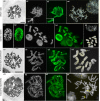Condensation patterns of prophase/prometaphase chromosome are correlated with H4K5 histone acetylation and genomic DNA contents in plants
- PMID: 28854212
- PMCID: PMC5576753
- DOI: 10.1371/journal.pone.0183341
Condensation patterns of prophase/prometaphase chromosome are correlated with H4K5 histone acetylation and genomic DNA contents in plants
Abstract
Mitotic prophase chromosome condensation plays an essential role in nuclear division being therefore regulated by highly conserved mechanisms. However, degrees of chromatin condensation in prophase-prometaphase cells may vary along the chromosomes resulting in specific condensation patterns. We examined different condensation patterns (CPs) of prophase and prometaphase chromosomes and investigated their relationship with genome size and distribution of histone H4 acetylated at lysine 5 (H4K5ac) in 17 plant species. Our results showed that most species with small genomes (2C < 5 pg) (Arachis pusilla, Bixa orellana, Costus spiralis, Eleutherine bulbosa, Indigofera campestris, Phaseolus lunatus, P. vulgaris, Poncirus trifoliata, and Solanum lycopersicum) displayed prophase chromosomes with late condensing terminal regions that were highly enriched in H4K5ac, and early condensing regions with apparently non-acetylated proximal chromatin. The species with large genomes (Allium cepa, Callisia repens, Araucaria angustifolia and Nothoscordum pulchellum) displayed uniformly condensed and acetylated prophase/prometaphase chromosomes. Three species with small genomes (Eleocharis geniculata, Rhynchospora pubera, and R. tenuis) displayed CP and H4K5ac labeling patterns similar to species with large genomes, whereas a forth species (Emilia sonchifolia) exhibited a gradual chromosome labeling, being more acetylated in the terminal regions and less acetylated in the proximal ones. The nucleolus organizer chromatin was the only chromosomal region that in prometaphase or metaphase could be hyperacetylated, hypoacetylated or non-acetylated, depending on the species. Our data indicate that the CP of a plant chromosome complement is influenced but not exclusively determined by nuclear and chromosomal DNA contents, whereas the CP of individual chromosomes is clearly correlated with H4K5ac distribution.
Conflict of interest statement
Figures




Similar articles
-
Different types of plant chromatin associated with modified histones H3 and H4 and methylated DNA.Genetica. 2011 Mar;139(3):305-14. doi: 10.1007/s10709-011-9550-8. Epub 2011 Feb 15. Genetica. 2011. PMID: 21327493
-
The centromeric heterochromatin of Costus spiralis: poorly methylated and transiently acetylated during meiosis.Cytogenet Genome Res. 2011;135(2):160-6. doi: 10.1159/000331231. Epub 2011 Sep 17. Cytogenet Genome Res. 2011. PMID: 21934285
-
Differential immunostaining of plant chromosomes by antibodies recognizing acetylated histone H4 variants.Chromosome Res. 1996 Apr;4(3):191-4. doi: 10.1007/BF02254958. Chromosome Res. 1996. PMID: 8793202
-
Higher organization and histone modification of the plant nucleus and chromosome.Cytogenet Genome Res. 2010 Jul;129(1-3):55-63. doi: 10.1159/000314639. Epub 2010 Jul 13. Cytogenet Genome Res. 2010. PMID: 20628249 Review.
-
Phosphorylation of histone H3 in plants--a dynamic affair.Biochim Biophys Acta. 2007 May-Jun;1769(5-6):308-15. doi: 10.1016/j.bbaexp.2007.01.002. Epub 2007 Jan 19. Biochim Biophys Acta. 2007. PMID: 17320987 Review.
Cited by
-
CMA/DAPI Banding of Plant Chromosomes.Methods Mol Biol. 2023;2672:215-224. doi: 10.1007/978-1-0716-3226-0_12. Methods Mol Biol. 2023. PMID: 37335478
-
Epigenetic histone H3 phosphorylation marks discriminate between univalent- and bivalent-forming chromosomes during canina asymmetrical meiosis.Ann Bot. 2024 Apr 10;133(3):435-446. doi: 10.1093/aob/mcad198. Ann Bot. 2024. PMID: 38127060 Free PMC article.
References
-
- Sumner AT. Chromosomes: Organization and Function. North Berwick. 287 p; 2003.
-
- Meng Y, Yi X, Li X, Hu C, Wang J, Bai L et al. The non-coding RNA composition of the mitotic chromosome by 5’-tag sequencing. Nucleic Acids Res. 2016; 44(10): 4934–4946. doi: 10.1093/nar/gkw195 - DOI - PMC - PubMed
-
- Kuroiwa T. Asynchronous condensation of chromosomes from early prophase to late prophase as revealed by electron microscopic autoradiography. Exp Cell Res. 1971; 69(1): 97–105. - PubMed
-
- Drouin R, Lemieux N, Richer CL. Chromosome condensation from prophase to late metaphase: relationship to chromosome bands and their replication time. Cytogenet Cell Genet. 1991; 57(2–3): 91–99. - PubMed
-
- Heitz E. Das Heterochromatin der Moose. Jahrb Wiss Bot. 1928; 69: 762–818.
MeSH terms
Substances
LinkOut - more resources
Full Text Sources
Other Literature Sources
Miscellaneous

